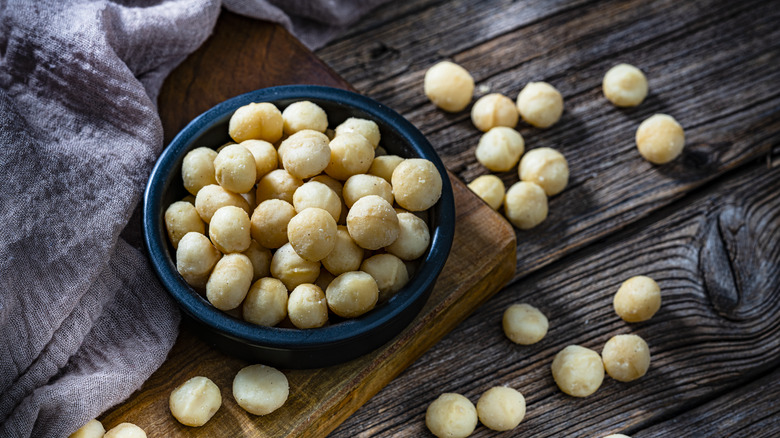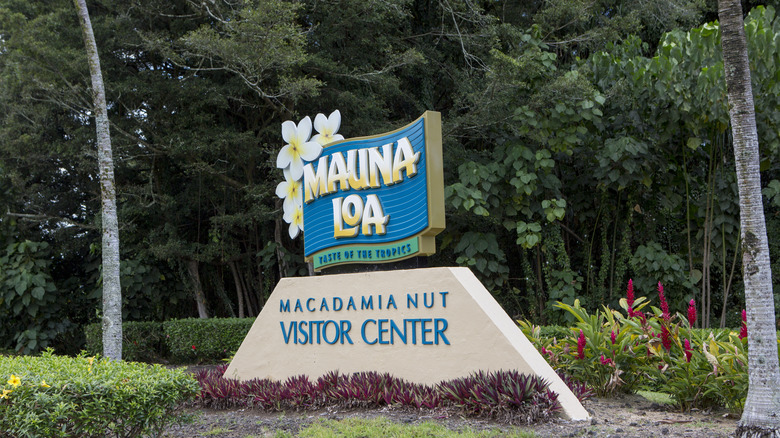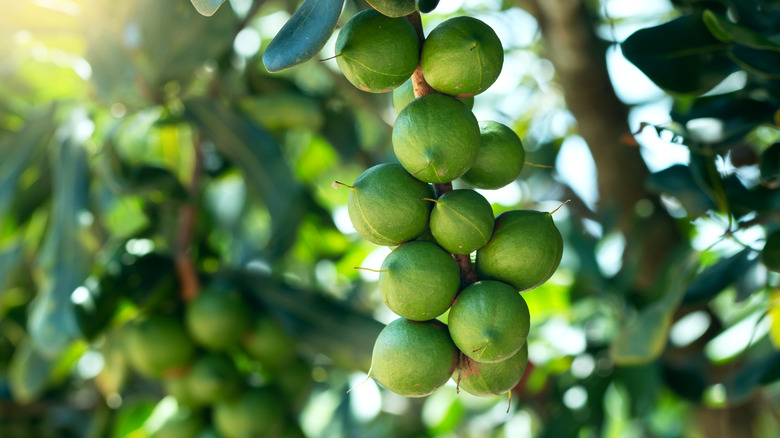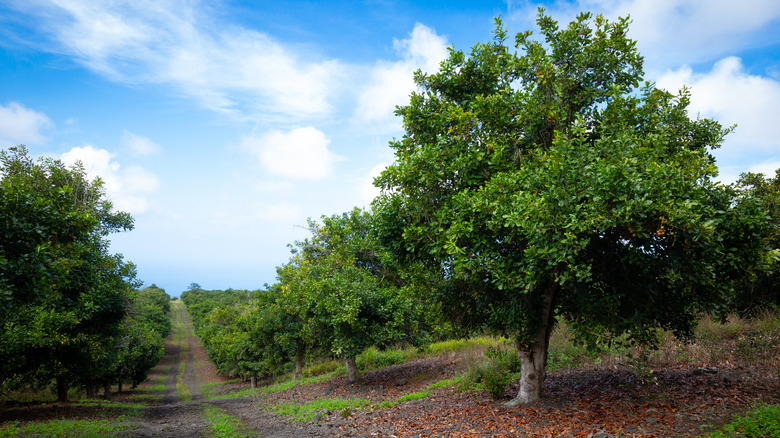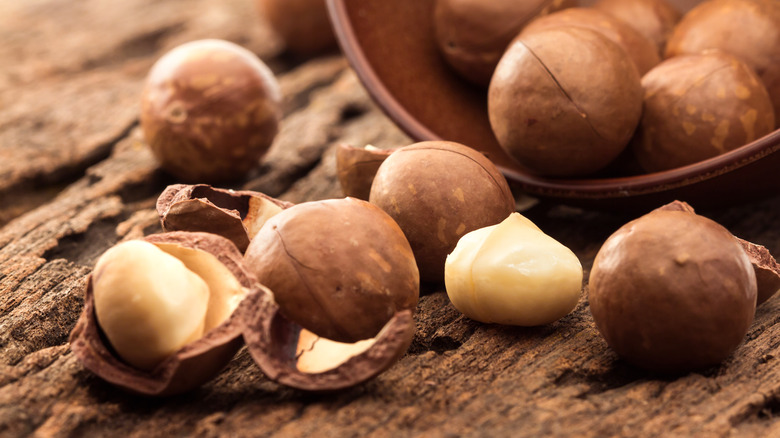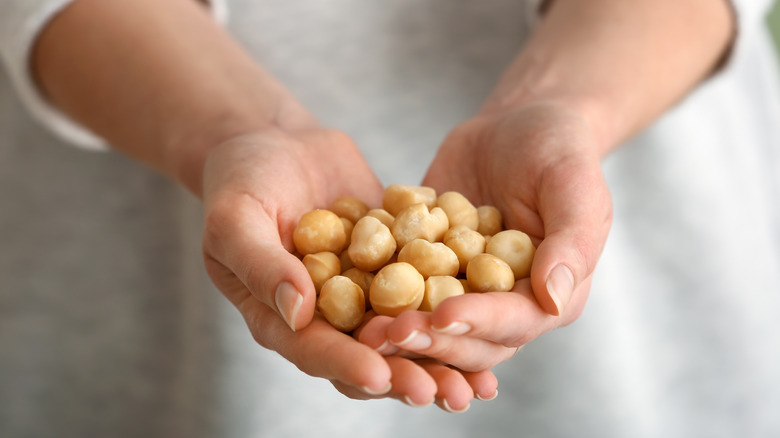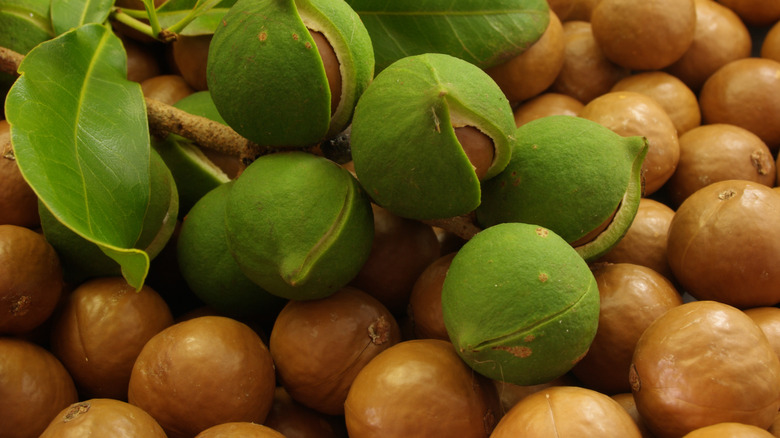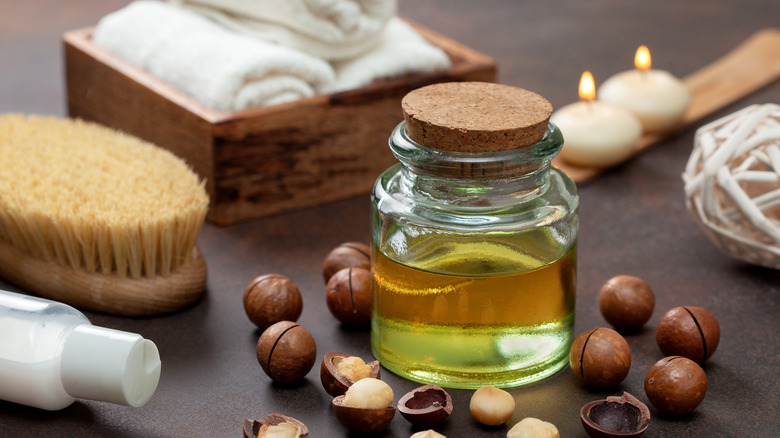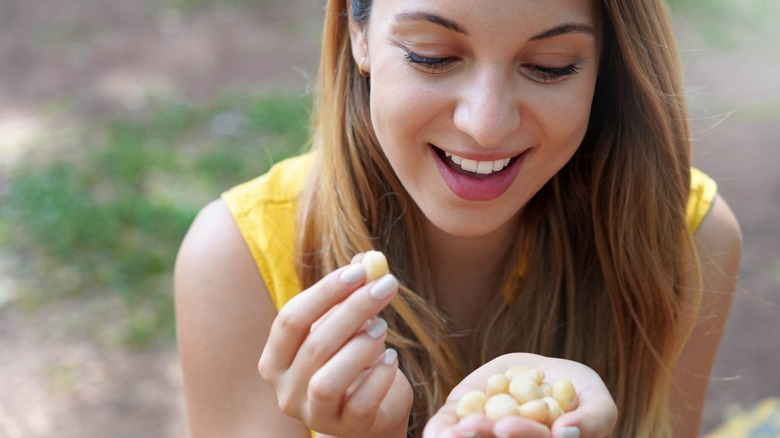10 Facts About Macadamia Nuts You Might Not Know
With their rich, buttery taste, their variety of uses, and their intriguing cultural history, it's no wonder that macadamia nuts have a solid place as one of the favorite nuts worldwide. Originally from Australia's lush and fertile rainforests, these delightful little morsels have a far-reaching and fascinating tie to Australian Aboriginal culture. Today, they're known and loved worldwide -– macadamia nuts are grown in a variety of regions, like Central America and the South Pacific.
Bakers love these nuts for their rich taste and delectable crunch in chocolates, cookies, and pastries. Even savory dishes can be brought to new heights by including macadamia nuts, whether they're raw, toasted, or simply as a garnish. But we don't love the macadamia nut just because of its delightful flavor and fascinating history — they also pack a nutritional punch as well. Loaded with healthy monosaturated fats and essential minerals like magnesium and manganese, these nuts have a whole lot to offer in the health department.
Let's dive deep into some fascinating facts about that macadamia nut that you probably never knew, and a reason why you might want to think twice before digging into a bit bowl of them.
1. Hawaiians have some serious love for the macadamia nut
Macadamia nuts may have their roots in Australia, but today, they have an unbreakable link to Hawaii's economy and cultural cuisine. Even though the macadamia tree was completely foreign to the islands a century and a half ago, Hawaii is now one of the largest producers and exporters of macadamia nuts in the world. The story of how these delectable little nuts became such a big part of Hawaiian culture traces back to a man named William Purvis and the natural fertility of the islands that makes them an ideal growing region.
Purvis, a prominent agriculturist and botanist, introduced macadamia nuts to the Hawaiian islands for the first time in 1881. Purvis saw the potential to cultivate the nut in Hawaii's lush soil enriched with volcanic ash. Over the years, the macadamia nut proved to be a hardy and resilient crop that thrived in the islands' volcanic soils, abundant sunshine, and tropical rainfall.
Fast forward to today, and Hawaii has firmly established itself as one of the leading global producers of macadamia nuts — in fact, according to the National Agricultural Statistics Service, Hawaii produced 40.7 million pounds of macadamia nuts in the 2019-2020 growing season. Locals and tourists alike can enjoy various Hawaiian dishes and desserts, from roasted and flavored nuts to chocolates, cookies, and oils.
2. These nutshells are super difficult to crack
Despite their delightful taste and versatile culinary applications, there's one significant problem that macadamia nuts present to their growers and manufacturers — they're notoriously difficult to crack open. In fact, these nuts actually have the toughest shells in the world, taking almost 300 pounds per square inch of pressure to crack just one nut. Unlike other nuts that can be cracked open by hand, macadamia nuts have remarkably hard and robust shells that require tools and machinery to open, and your standard kitchen nutcracker won't cut it.
This presents a special challenge to macadamia nut growers since it can lead to increased production costs and can limit the supply of these sought-after nuts. To address this issue, specialized machines have been designed that utilize hydraulic and pneumatic pressure to crack open the formidable shell on a mass scale. These advancements have significantly improved the productivity of the macadamia nut industry, ensuring that more of these delectable nuts can make their way into the market for consumers to enjoy.
3. The trees can live for up to 100 years
In the world of nut trees, longevity is a rare trait. Many nut-bearing trees have relatively short lifespans. However, the macadamia nut tree boasts an impressive lifespan that can extend well beyond a century. Part of the reason macadamia nut trees live as long as they do is because of their adaptability to a variety of climates and soil conditions. This makes them a successful crop in several regions around the world with warm weather and lush soil, like Hawaii, California, South Africa, and Central and South America.
Though macadamia trees have the potential to live a long life, they don't bear fruit the entire time. They can take up to five years to reach maturity before they start producing their first crop of nuts. This slow growth phase at the beginning of their life is called the juvenile period, where much of the plant's energy is reserved for establishing a robust root system and strong branches.
Once the trees are past the juvenile phase, they can continue to bear nuts for decades, typically around 40 to 60 years. During this period, they can produce a consistent yield of about 30 to 50 pounds per growing season. Since this crop has such a substantial lifespan, macadamia nut trees need careful and sustainable management to ensure their continued productivity and health. Pruning, pest control, and proper irrigation all play a role in optimizing its longevity.
4. A nutritious and delicious nut
Beyond their delectable taste, these creamy, buttery nuts are packed with healthy fats and essential nutrients that make them a satisfying and wholesome snack choice. And while they're certainly high in calories, they can be an excellent addition to a healthy lifestyle when consumed in moderation.
Macadamia nuts are especially known for their high-fat content, which makes up approximately 75% of their weight. However, not all fats are created equal, and macadamia nuts shine in this regard. Remarkably, about 80% of the fats in macadamia nuts are monounsaturated fats, often referred to as "healthy" fats. These monounsaturated fats are the same heart-healthy fats found in avocados and olive oil and are known to have a positive impact on cardiovascular health and reduce LDL cholesterol levels.
Macadamia nuts also boast a balanced ratio of omega-6 to omega-3 fatty acids. Maintaining an appropriate balance of these essential fatty acids is crucial for promoting brain health and inflammation regulation. The anti-inflammatory properties of macadamia nuts can be beneficial in reducing the risk of chronic inflammation and related health conditions.
Macadamia nuts are also a rich source of various essential vitamins and minerals. According to Medical News Today, they are particularly abundant in manganese, thiamin (vitamin B1), and magnesium. Manganese supports bone health and aids in the body's metabolism of macronutrients, while thiamin is essential for energy production and nerve function. Magnesium plays a vital role in muscle and nerve function, supporting a healthy immune system and promoting overall well-being, Medical News Today notes.
5. Macadamia nuts are super high in saturated fats
Sure, macadamia nuts are packed with nutritional benefits, but there are a few reasons why you may not want to indulge – specifically, their high saturated fat content. For people with specific health conditions such as heart disease or high cholesterol, understanding the fat composition of macadamia nuts is essential in making informed choices about their inclusion in one's diet.
Even though macadamia nuts are known for their high amount of heart-healthy monounsaturated fats, they still contain a notable amount of saturated fats. About 75% of a macadamia's weight is made up of fat, and about 20% of that fat is saturated fat. According to the American Heart Association, saturated fats are associated with raising levels of LDL cholesterol, often referred to as "bad" cholesterol. High LDL cholesterol is a known risk factor for heart disease because it can contribute to the formation of plaque in the arteries.
However, this doesn't mean that macadamia nuts need to be avoided entirely. When enjoyed in moderation, macadamia nuts can still be part of a heart-healthy diet. Incorporating a limited amount of these nuts, along with a diverse range of other nutritious foods, can provide a delicious and nutrient-rich addition to one's meals and snacks.
6. The most expensive nuts in the world
Nuts are known for being a bit pricey in general, but when it comes to cost, macadamia nuts come out on top. In 2023, the wholesale price of macadamia nuts ranged from about $3.17 to $6.35 per pound, surpassing the cost of any other nut on the market. There are several reasons why these nuts cost so much that show up at each stage of the growing and shipping processes.
One of the primary reasons behind the lofty price of macadamia nuts is the delicate balance between their limited supply and the consistently high demand for their unique taste and texture. Macadamia nuts also have a bit of a reputation as a luxury and "dessert" nut because of their rich, buttery flavor and melt-in-your-mouth texture. They are frequently used in high-end macadamia desserts, premium chocolates, and other luxurious treats.
Harvesting and processing macadamia nuts is a task that requires specialized machinery due to the exceptional hardness of their shells. The need for specialized machinery adds to the price, but there are also the shipping costs associated with distributing macadamia nuts from their somewhat isolated growing regions to global markets. As the majority of macadamia nuts are grown in the South Pacific and South Africa, the transportation of these nuts to other parts of the world involves expensive long-distance shipments.
7. Aboriginal Australian people have strong ties to macadamia nuts
For the Aboriginal Australian people, the macadamia nut holds a special place in their history, culture, and daily life. Indigenous to the eastern slopes of Australia's Great Dividing Range, macadamia trees have thrived for thousands of years, providing a valuable and cherished resource for Aboriginal communities. The nuts were a vital part of their diet, offering sustenance-rich fats that provided them with the energy needed to endure their daily activities and long journeys.
Revered for their taste and nutritional value, the nuts were affectionately referred to as "Boombera," and "Jindilli." The macadamia nut also played a role in Aboriginal people's traditions and ceremonies. In some communities, the nuts were used for bartering and trading, serving as an important item of exchange in social and cultural interactions.
Additionally, the macadamia tree itself held spiritual significance for some Aboriginal groups. These majestic trees were often considered sacred, and their nuts were regarded as a gift from the land, symbolizing the bond between the people and the natural world. Today, the strong ties between the Aboriginal Australian people and the macadamia nut endure, and organizations like the Macadamia Conservation Trust work with Aboriginal communities to preserve the nut's natural habitat and cultural significance.
8. Macadamia nuts are great for so much more than cookies
We all know and love the delightfully rich taste of macadamia nut cookies, but these versatile nuts have much more to offer than just sweet treats. Macadamia nuts can be used in a variety of culinary and non-food applications, making them a valuable addition not only to your pantry but to your beauty regimen, as well.
When it comes to cooking and baking, macadamia nuts are just as versatile as they are delicious. Their high-fat content and creamy texture make them an excellent non-dairy substitute for various recipes. Ground macadamia nuts can serve as a wonderful alternative to traditional dairy products like butter and milk, adding richness and depth of flavor to everything from sauces to coffee. They can also be used to create creamy dressings and dips or incorporated into savory dishes like nut-stuffed vegetables and nut-based spreads.
Beyond culinary applications, the oils and fats extracted from macadamia nuts have found their way into the realm of beauty and skincare products. The nourishing properties of macadamia nut oil make it an ideal ingredient in lotions, shampoos, conditioners, and moisturizers. Its lightweight texture makes it suitable for hydrating and nourishing the skin and hair, promoting softness and a healthy glow, without clogging pores or adding oiliness to the hair.
9. They're toxic to dogs and cats
While macadamia nuts are a delicious snack for humans, they can spell trouble for our beloved animal companions. Macadamia nuts are highly toxic to dogs and cats, and eating even a small amount can lead to a range of health issues and potentially severe consequences for our four-legged friends.
The exact toxin in macadamia nuts that affects pets is still not fully understood by veterinary experts. However, it is still clear that these nuts contain a harmful substance that can be dangerous when ingested by dogs and cats. Upon consumption, pets may experience a variety of symptoms, which can appear within a few hours of ingestion. Common signs of macadamia nut toxicity in pets include weakness, vomiting, and tremors. In severe cases, macadamia nut ingestion can even lead to muscle stiffness and paralysis, necessitating immediate veterinary attention.
Pet owners must be vigilant and take preventative measures to ensure that macadamia nuts are kept out of their furry companions' reach. These nuts should never be fed intentionally to dogs or cats, and care should be taken to prevent accidental ingestion. If you suspect that your pet has ingested macadamia nuts or notice any concerning symptoms, seek immediate veterinary attention or call the ASPCA's Animal Poison Control Hotline. Getting help within 24-48 hours can improve the chances of a successful recovery.
10. Not all macadamia nuts are safe to eat
Among the various species of macadamia nuts, only two are known for producing edible and safe-to-eat nuts: Macadamia integrifolia and Macadamia tetraphylla. These species are responsible for yielding the familiar and delicious macadamia nuts commonly found in markets and used in a wide range of culinary creations. If you go and pick up a bag of macadamia nuts from the store, it's going to be one of these two species.
However, some macadamia nut species, such as Macadamia whelanii and Macadamia ternifolia, are considered toxic and unsuitable for human consumption because of cyanogenic glycosides that are found in the nuts. Ingesting nuts from these toxic species can lead to gastrointestinal issues. To ensure your safety and enjoyment of macadamia nuts, it is crucial to be aware of the specific species you are consuming and to obtain them from reputable sources.
Choosing nuts from the edible species, Macadamia integrifolia and Macadamia tetraphylla, ensures that you are indulging in the delightful and safe varieties of these delectable nuts. Responsible sourcing and purchasing from trusted suppliers can help you avoid the risks associated with consuming toxic macadamia nut species. Furthermore, if you are harvesting macadamia nuts from trees or wild sources, it's essential to have a clear understanding of the specific species to avoid any potential health hazards. If you are unsure about the type of macadamia nuts you have, it is best to consult with an expert or avoid consumption altogether.
